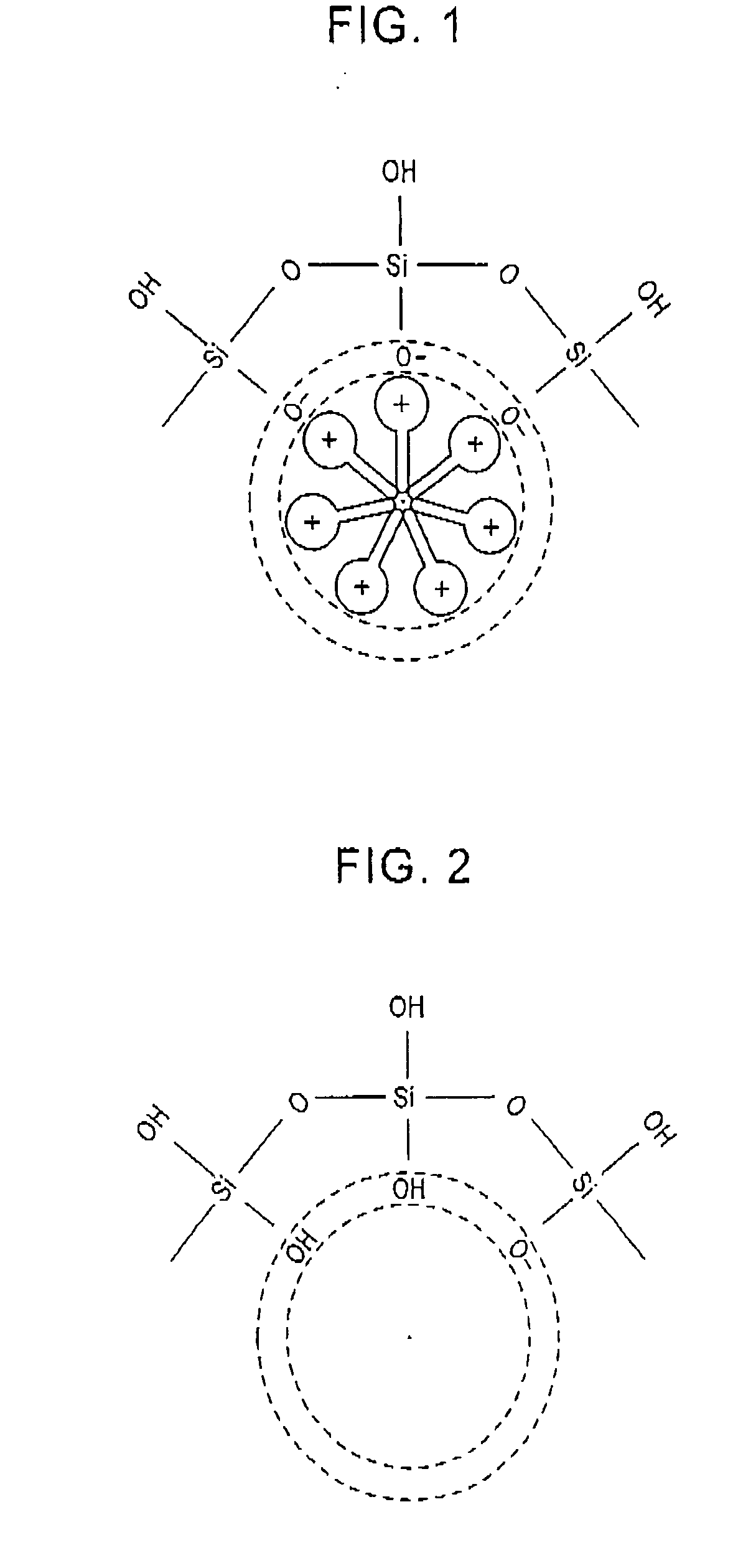Method for producing porous material
a technology of porous materials and porous materials, applied in the field of porous materials, can solve the problems of difficult shrinkage of porous materials, and achieve the effects of improving the temporal stability of porous materials, superior temporal stability, and difficult shrinkag
- Summary
- Abstract
- Description
- Claims
- Application Information
AI Technical Summary
Benefits of technology
Problems solved by technology
Method used
Image
Examples
example 1
[0104] In Example 1, a primary material is formed in a film (primary material film), and then the porogen in the primary material film is removed to form pores simultaneously with the inactivation of the reactive sites at the surface of the matrix defining the pores.
[0105] Evenly blended were 1.6 g of a matrix precursor, tetraethoxysilane Si(C2H5O)4, 7.8 g of ethanol, 0.7 g of water of pH 3, and 0.4 g of a porogen, hexadecyltrimethylammonium chloride to prepare a transparent and viscous solution. The solution was applied onto a substrate to form a primary material film by spin coating. The film was dried at 200° C. in a normal atmosphere, and then, the porogen hexadecyltrimethylammonium chloride was removed by supercritical extraction with the apparatus shown in FIG. 3, simultaneously with the inactivation, in the following manner.
[0106] After the substrate having the primary material film was place in the high-pressure container, carbon dioxide of 80° C. was introduced into the h...
example 2
[0108] In Example 2, the porogen in the primary material film was removed, and subsequently the reactive sites at the surface of the matrix were inactivated.
[0109] After a viscous solution was prepared in the same manner as in Example 1, the solution was applied onto a substrate by spin coating, followed by drying at 200° C. in a normal atmosphere. Then, the porogen hexadecyltrimethylammonium chloride was removed by supercritical extraction, and subsequently inactivation was performed with the same apparatus used in Example 1, in the following manner.
[0110] After the substrate having the primary material film was place in the high-pressure container, carbon dioxide of 80° C. was introduced into the high-pressure container and the internal pressure of the container was increased to 15 MPa to create a supercritical state. Methanol was introduced into the high-pressure container in the supercritical state. The volume proportion of the methanol was {fraction (1 / 10)} to the volume of c...
example 3
[0117] The following Example 3 is for the second embodiment.
[0118] Evenly blended were 1.6 g of a matrix precursor tetraethoxysilane Si(C2H5O)4, 7.8 g of ethanol, 0.7 g of water of pH 3, and 0.4 g of a porogen hexadecyltrimethylammonium chloride to prepare a transparent and viscous solution. The solution was applied onto a substrate to form a primary material in a film by spin coating. After the primary material film was heated at 100° C., an additional matrix precursor was supplied to the primary material film with the apparatus shown in FIG. 3 and the porogen was subsequently removed in the following manner.
[0119] The substrate having the primary material film was place in the high-pressure container. Carbon dioxide of 80° C. was introduced into the high-pressure container and the internal pressure of the container was increased to 15 MPa to create a supercritical state. A hexane solution containing 10% by volume of an additional matrix precursor tetraethoxysilane was introduced...
PUM
 Login to View More
Login to View More Abstract
Description
Claims
Application Information
 Login to View More
Login to View More - R&D
- Intellectual Property
- Life Sciences
- Materials
- Tech Scout
- Unparalleled Data Quality
- Higher Quality Content
- 60% Fewer Hallucinations
Browse by: Latest US Patents, China's latest patents, Technical Efficacy Thesaurus, Application Domain, Technology Topic, Popular Technical Reports.
© 2025 PatSnap. All rights reserved.Legal|Privacy policy|Modern Slavery Act Transparency Statement|Sitemap|About US| Contact US: help@patsnap.com


